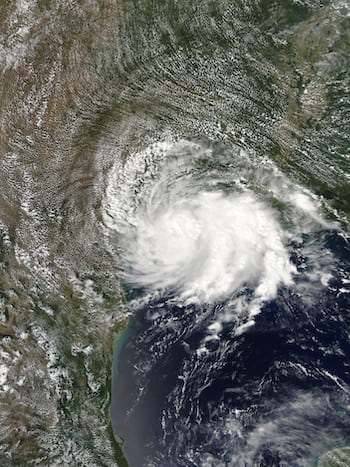Organizers ask Greater Houstonians to add their experience of September storm to survey
Organizers of the Hurricane Harvey Registry plan to update its database to include those who lived through Tropical Storm Imelda in September.
The registry, a joint effort by seven local health departments, the Environmental Defense Fund and Rice University, was introduced eight months after Harvey to build better understanding of the hurricane’s effects on the region. Those data are already being used by researchers to understand how weather events impact people’s physical and mental health.

A satellite view shows Tropical Storm Imelda shortly after landfall near Freeport, Texas, on Sept. 17, 2019. Image courtesy of NASA
The significant damage caused by Imelda prompted the registry team to add more than a dozen questions to the survey.
Those who have already participated are encouraged to log in and help the registry compile a more complete picture of the damage the surprise mid-September storm caused to people’s homes and health. New participants are welcome to complete the entire survey.
The update is the second conducted by the registry team, which earlier added questions about the impact of a May 2019 storm that battered the Houston region.
“Events are happening more frequently, and intense rainfall events more often, so there’s a growing recognition that we need to account for health and housing impacts, regardless of the name of the storm,” said Elena Craft, the Texas-based senior director for climate and health of the Environmental Defense Fund. “The registry was always meant to be a living tool that can be flexible enough to accommodate different events.”
The initial report prepared by Rice’s Children’s Environmental Health Initiative, led by Marie Lynn Miranda, a professor of statistics and director of the registry, gives an overview of data offered for the nearly 20,000 registrants and their families.
“Harvey changed our region and changed people’s lives,” Miranda said. “We still have neighbors who have not yet moved back into their homes, and health effects from the storm, both physical and mental, still affect people’s daily lives. While Imelda was not equal in size or scale to Harvey, it still had dramatic impacts. We need to understand the full impact of Imelda and Harvey — and subsequent storms — to better serve people today and to better prepare for the future.”
The registry is already being used in several studies. For example, Loren Hopkins, a Rice professor in the practice in statistics and chief environmental science officer for the Houston Health Department’s Bureau of Community and Children’s Environmental Health, is using registry data to add detail to an ongoing study of childhood asthma in specific Houston ZIP codes.
“The registry provides much more detail on what the areas of the city were exposed to, the level of the water, the debris and how long they were in or out of their homes,” Hopkins said. “The point of the study is to understand how to better support children with asthma and their families in an emergency.”

